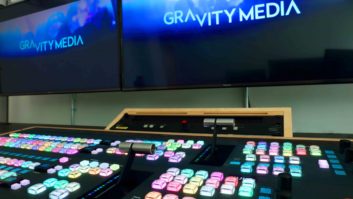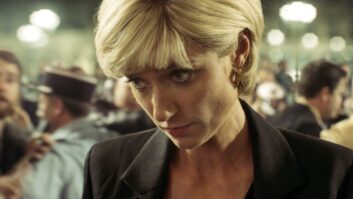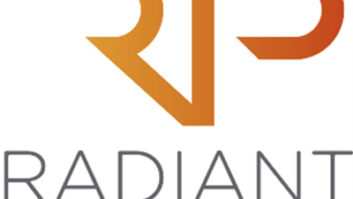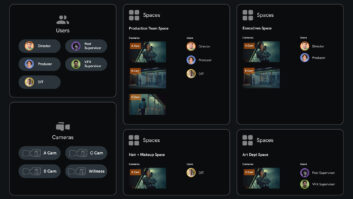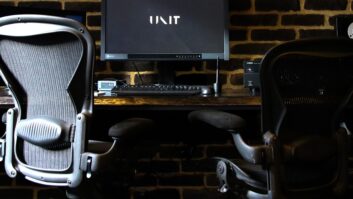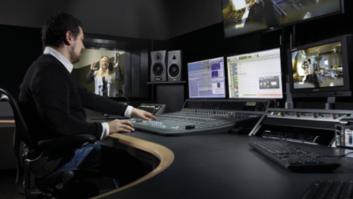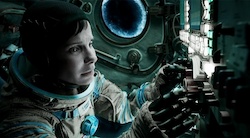
“Twenty years ago what we did, along with every other facility, was termed post production,” declared William Sargant, co-founder and CEO, Framestore. “Now that term is no longer relevant. What we do is digital production.”
Framestore was the lead visual effects house on Alfonso Cuaron’s Gravity, widely tipped for an Oscar nomination in such categories as visual effects and cinematography.
“A few years ago the percentage of shots in a film or TV show touched by computers was small,” said Sargant. “Now the percentage of shots can regularly be 50-60% or more and when you add to that that the majority of imagery is now captured digitally, people like us become an essential element of storytelling. We are embedded in pre-vis and production design solving problems from inception to completion.”
Much of Gravity was shot in a 3mx3m space rigged with over 4000 LED bulbs for cinematographer Emmanuel Lubezki to create the lighting effects.
“Emmanuel spent one week a month over the best part of a year pre-planning the lighting with our artists,” explained Sargant. “His cinematography was virtual in the sense that he’d say ‘I want to place my lights 12,000 miles away’. That would be a normal conversation. On a physical set the lights would be 40ft [13m] away, but he had no problem conceptualising that the sun was one of his light sources, or in using the light reflected off the earth. He is still using a director of photography’s traditional craft skills to frame and light a scene but he has a different set of people on his team helping to enhance the photography.”
The film’s stereo supervisor Chris Parks of Vision3 was involved a full year before principal photography began.
“The first conversation I had with Alfonso was him explaining ‘this is going to be in 3D, what do we need to think about’,” said Parks. “We talked about how his long signature shots, in which the camera moves around the subject, could work fantastically well in 3D and about using wide angle lenses to achieve the type of roundness and volume he was looking for.”
In 2010 when Cuaron approached the British stereographer, the intention was to shoot in native 3D.
“I ran some tests with Chivo [Lubezki] using Alexas on 3Ality rigs at Leavesden Studios to give Alfonso a taste for how 3D could enhance the feeling of weightlessness and how stereo could work with camera movement and lighting.”
The use of wide-angle lenses throughout the shoot enabled Parks to pull elements into the theatre space. These included sun flares, debris such as a ballpoint pen, air bubbles and parts of the escape pods.
“We were able to make narrative use of 3D because Alfonso had integrated 3D with cinematography, visual effects and every other craft department from the outset,” added Parks.
To capture the fluidity of movement that Cuaron and Lubezki wanted it was eventually decided to use robotic camera arms, for which the bulk and weight of the dual 3D cameras were unsuitable.
“There were several scenes that I would have loved to shoot natively but at the end of the day it was impossible to get the rigs into the confined spaces, or to support them on the robotic arms, needed to get the zero gravity feel,” he said.
About 25 minutes of the movie, notably shots of the two capsules and the film’s final shot, was post converted at Prime Focus London under Parks’ supervision. The exterior scenes, with the exception of the final shot, were principally stereo rendered CG. In conjunction with Framestore and vfx superviser Tim Webber, Parks used a ‘Virtual Rig’ and was able to manipulate the amount of depth per shot in a similar manner to operating the inter-axial distance between native stereo cameras.
Framestore won its first Academy Award for the VFX on The Golden Compass (2008), shared with Rhythm & Hues and the film’s VFX supervisor Mike Fink. The facility was also nominated for Superman Returns (2007), The Dark Knight (2009), and Harry Potter and the Deathly Hallows – Part 1 (2010). It also contributed shots to Avatar (2009).
“It would be tempting fate to talk up our chances [for Gravity] this year,” said Sargant. “There is great work by Weta and ILM. It is in the lap of the gods.”
Of the Golden Compass win, Sargant said: “It is a validation of your work but it doesn’t get you your next job or put a premium on your next work. The nominations themselves are of real value because you are being judged by a community of peers, whereas the final vote is made by the entire Academy.”
Aside from Gravity, Framestore has worked on recent or upcoming releases including The Secret Life of Walter Mitty, Inside Llewyn Davis and 47 Ronin. It is currently working on projects including Jupiter Ascending, Paddington, Robocop, Dracula Untold and Edge of Tomorrow.
Although Framestore has won 14 Emmys, VFX for TV is not currently a focus for the company, but Sargant does not rule it out.
“We do three to four movies a year and TV, I am sure, will be part of the mix. We are fully booked until next year but if the right project came across our desk we would look at it. TV has tighter budgets and faster turnaround times but can also provide more creative freedom than features work. On TV there is generally just one VFX house involved, whereas in most features you could be one of many houses supplying a single scene or part of a scene.
“The TV visual effects industry in this country benefits from the UK’s strong community in commercials and features. With the introduction of the UK TV tax break I think you will see more innovative work being done in VFX for TV in the UK over the next three years.”
By Adrian Pennington
